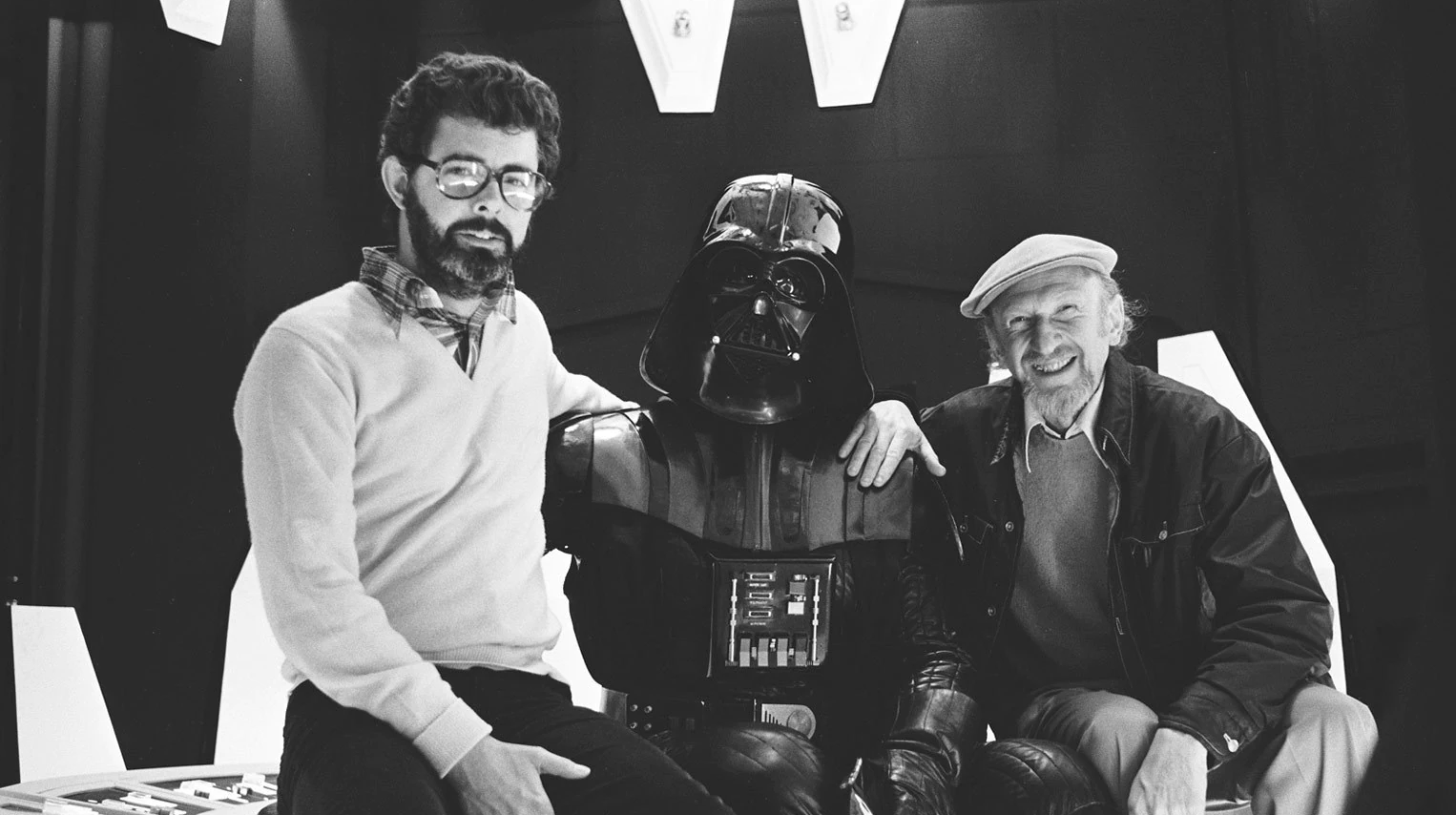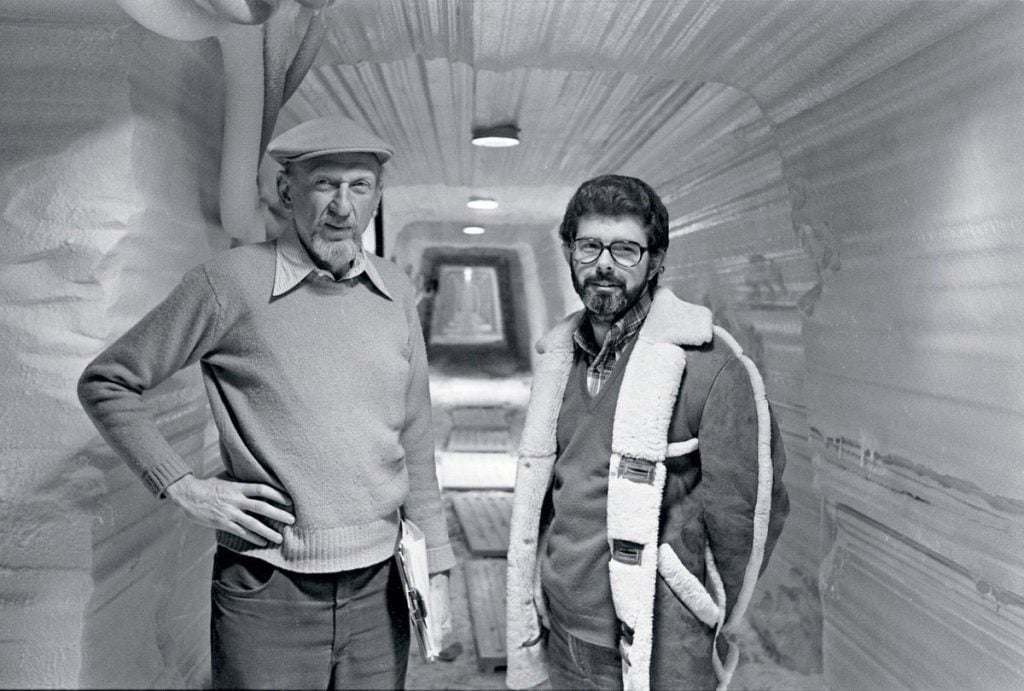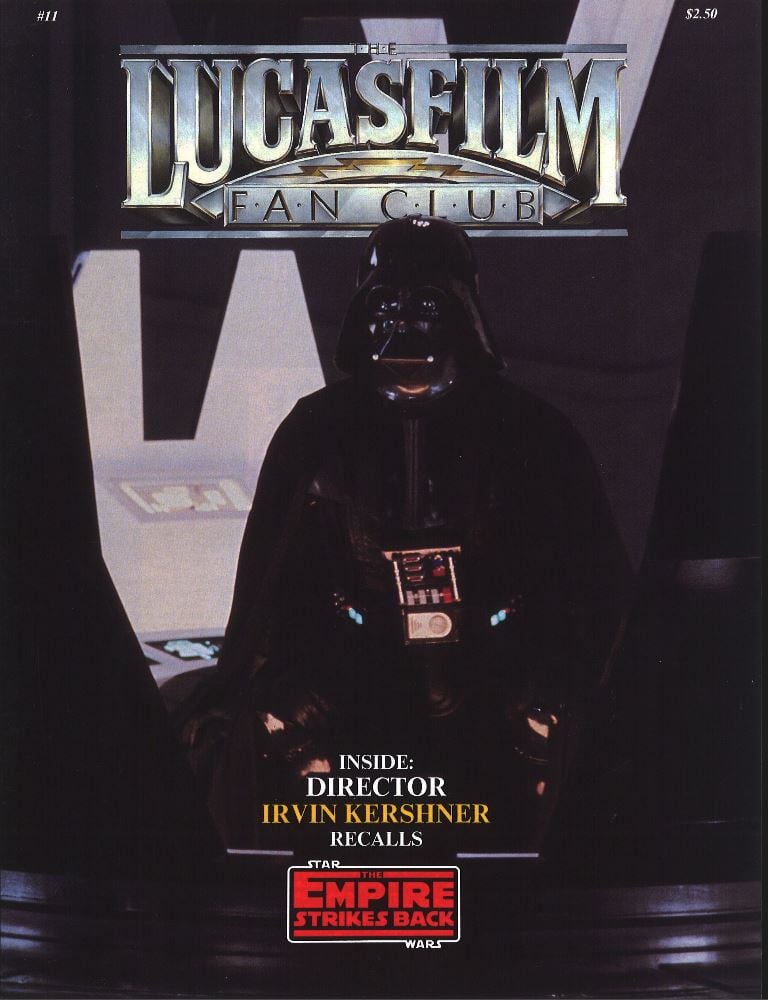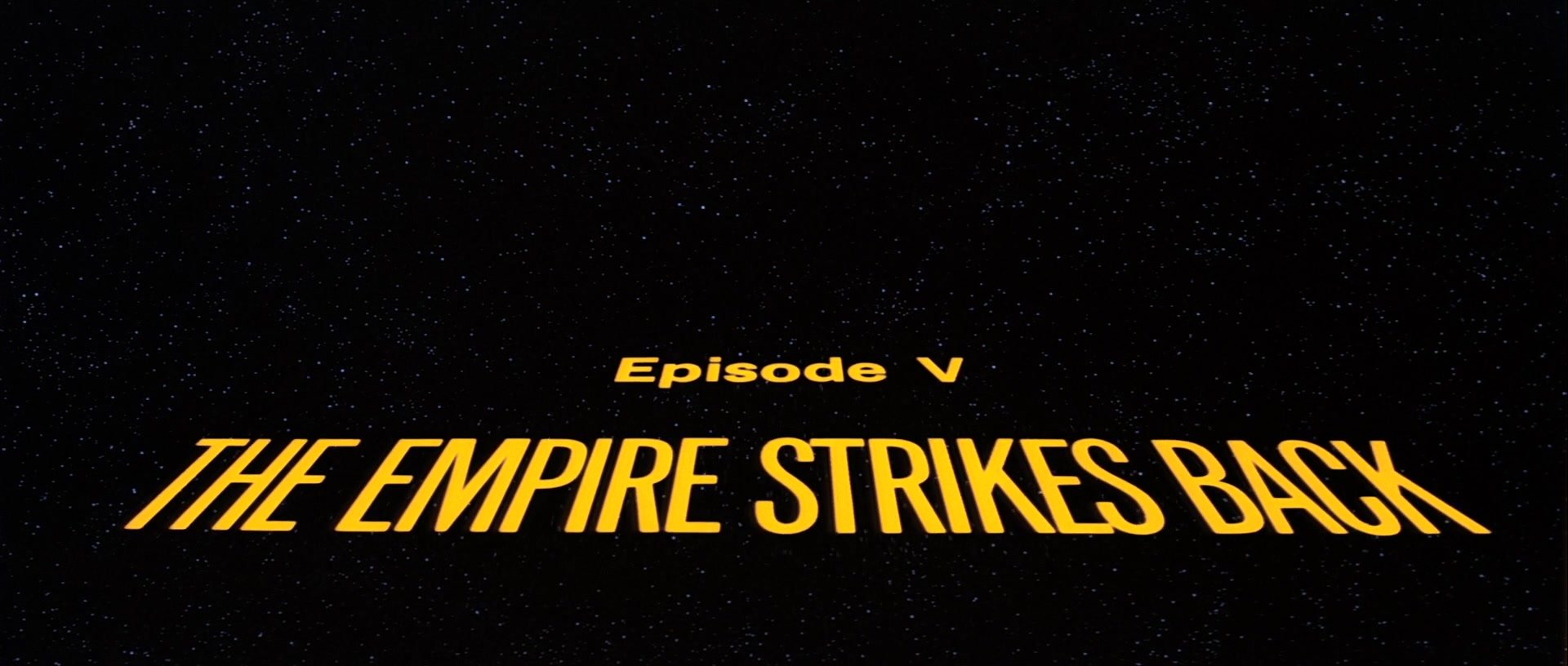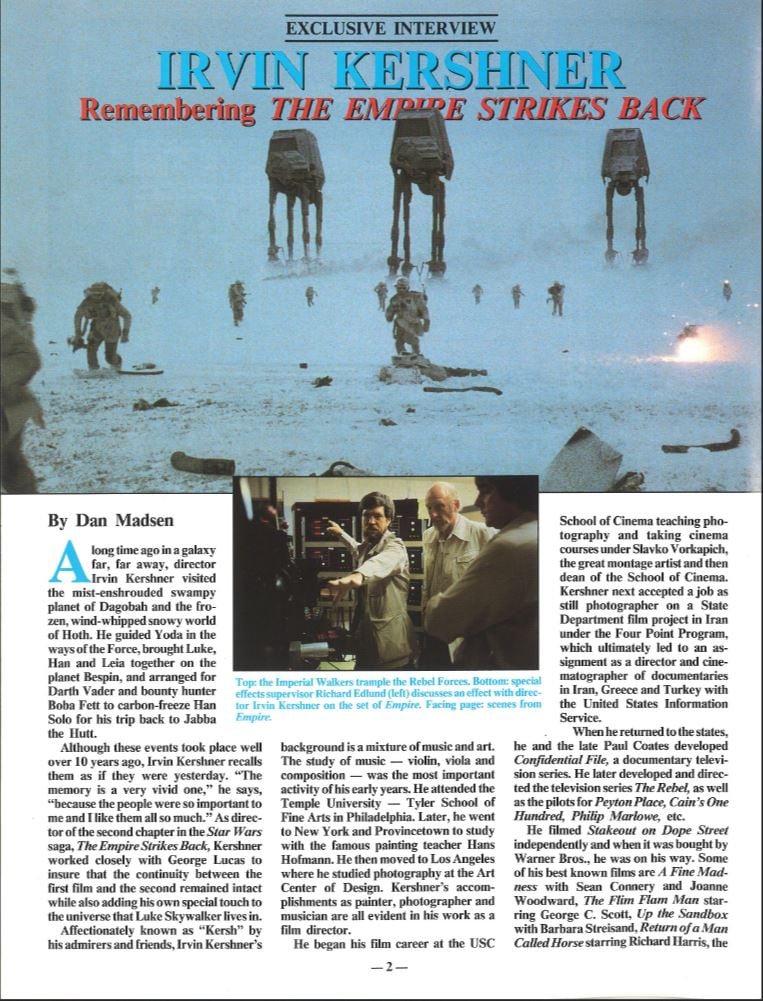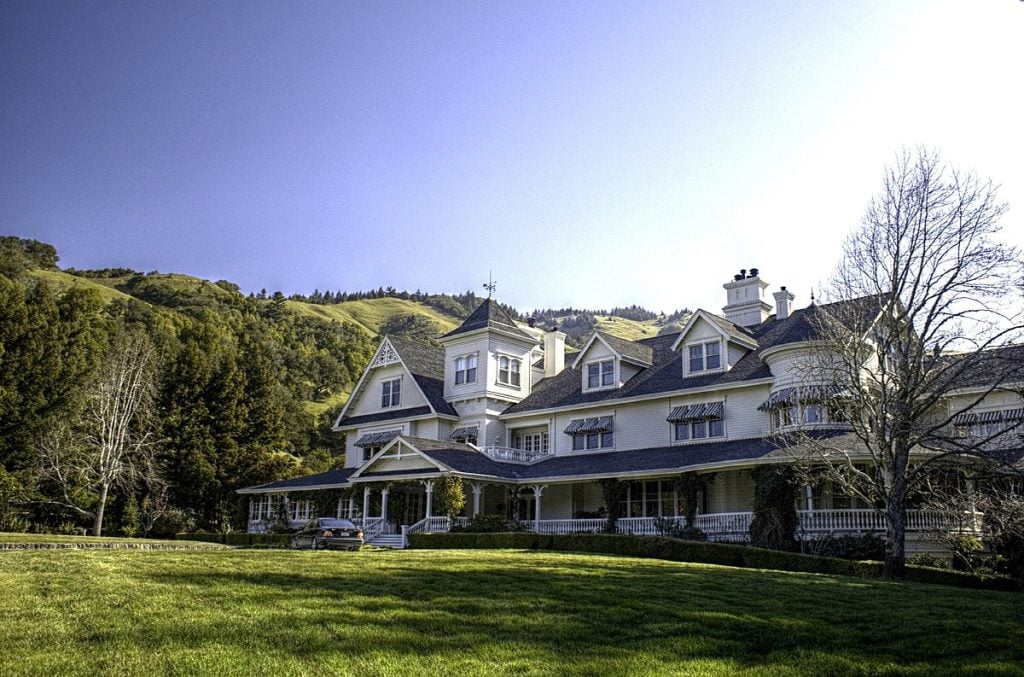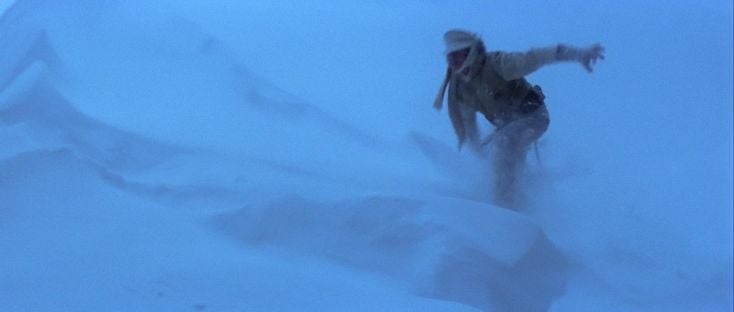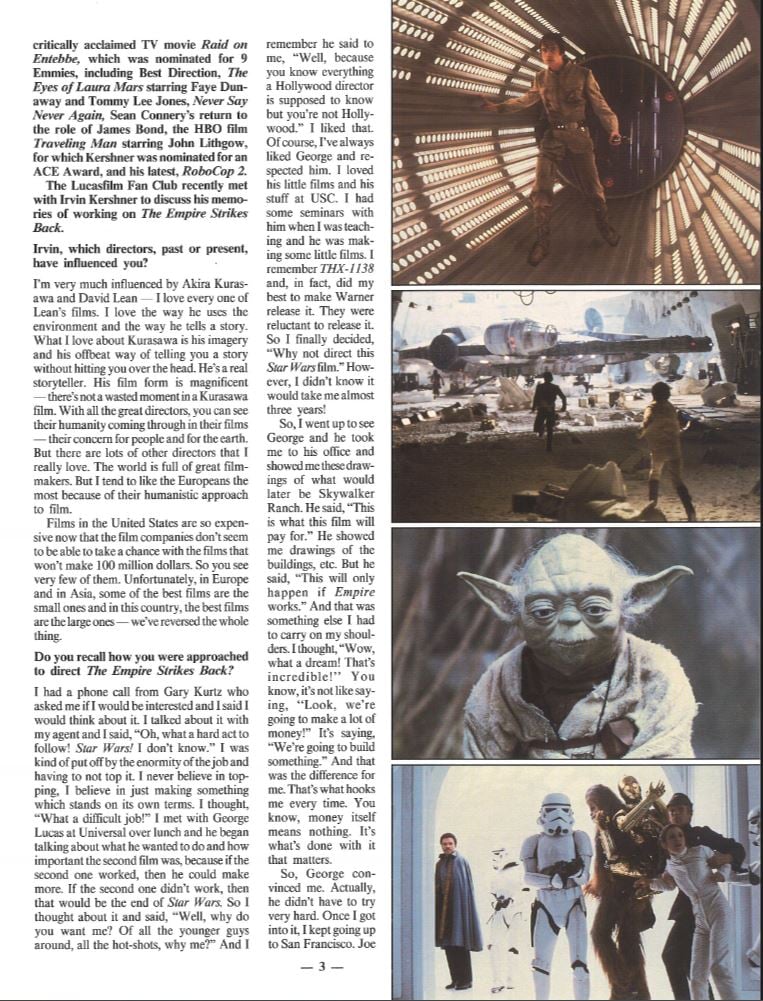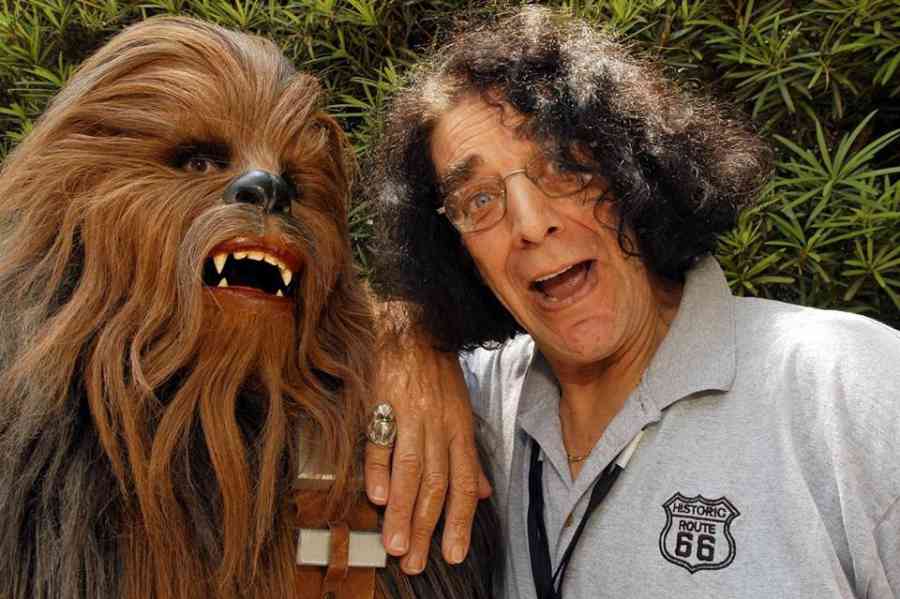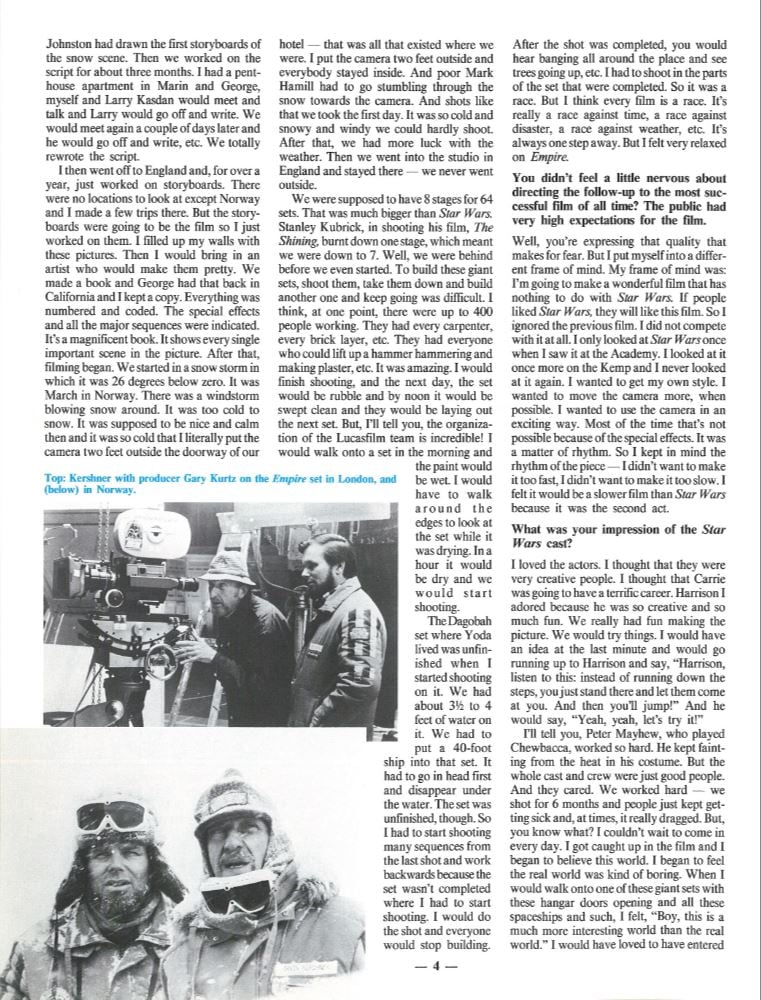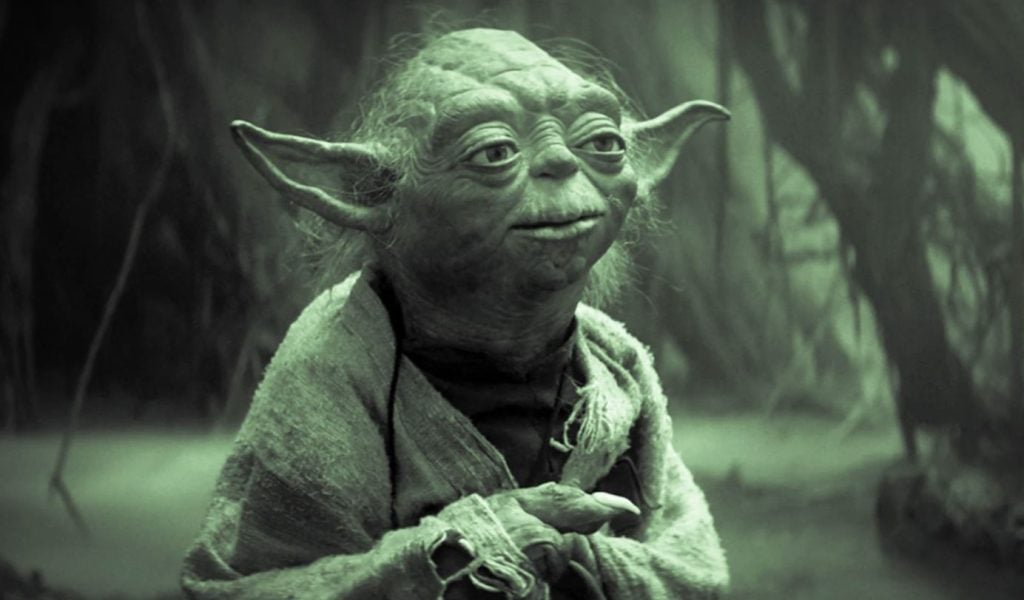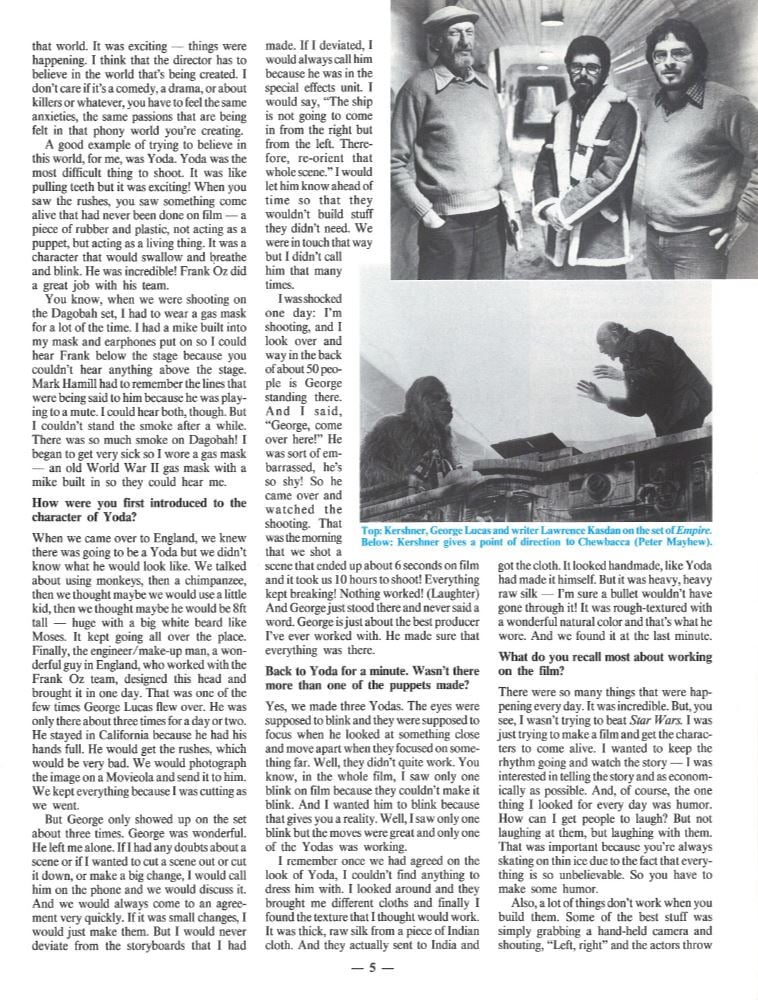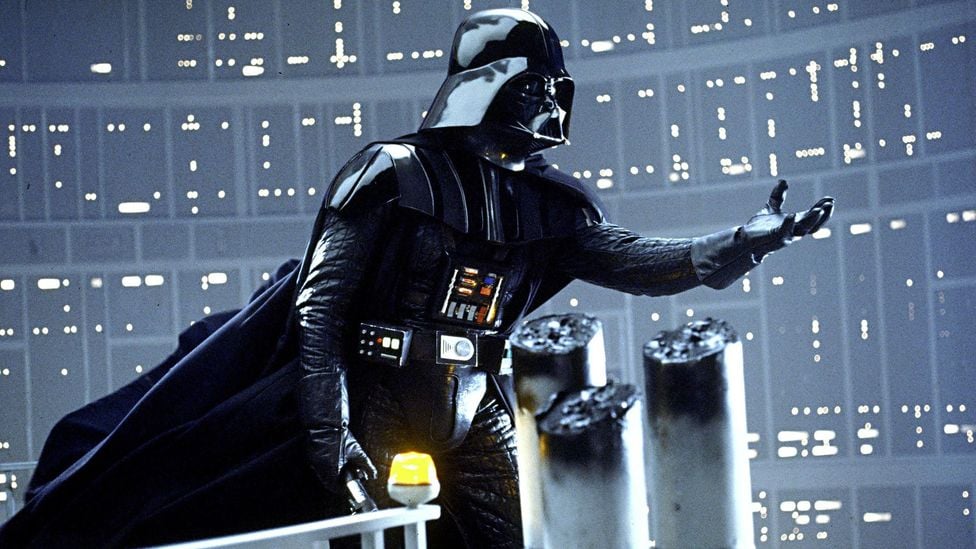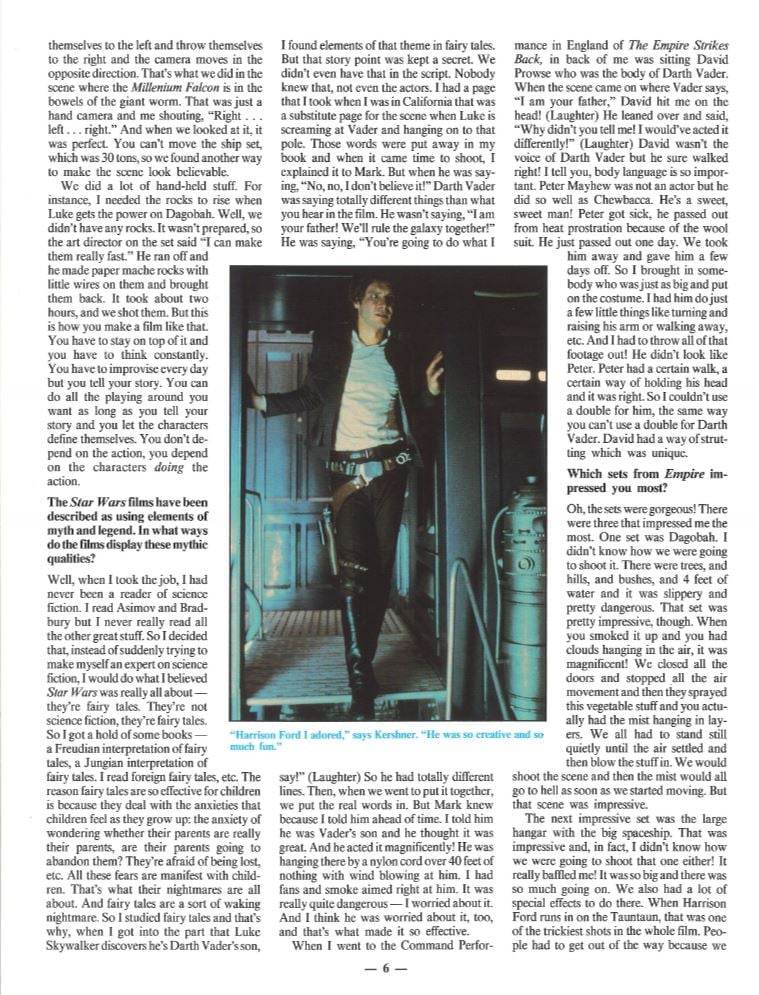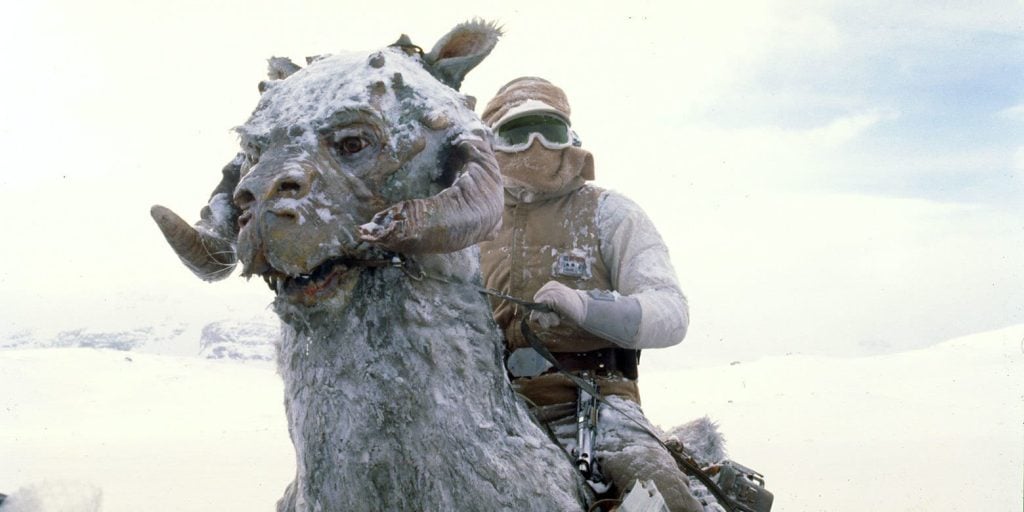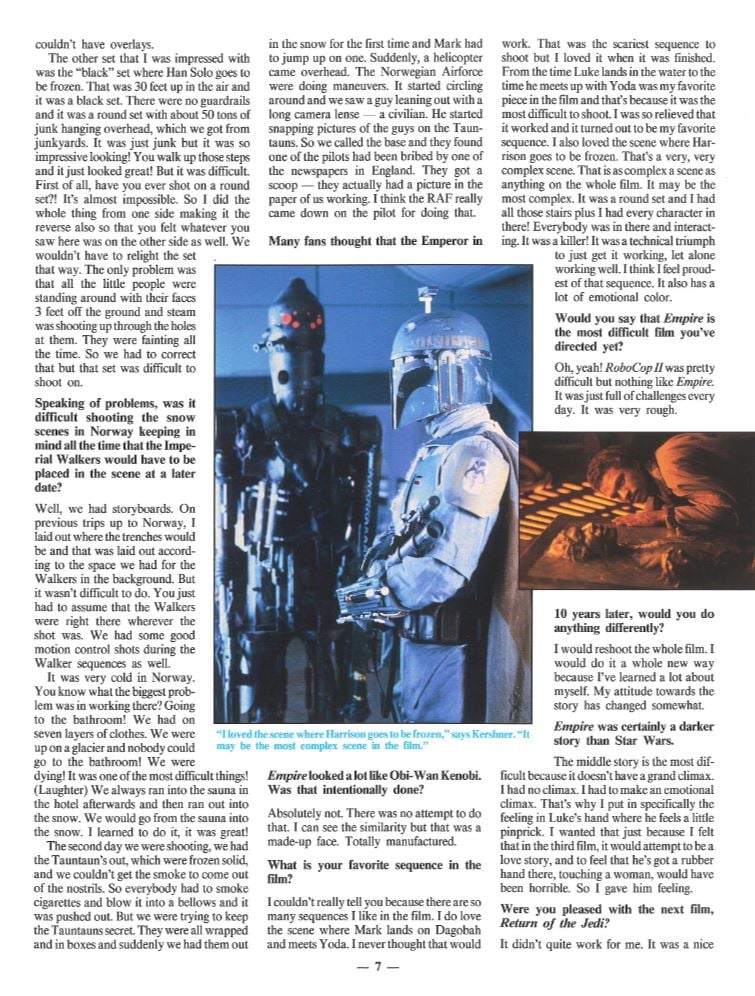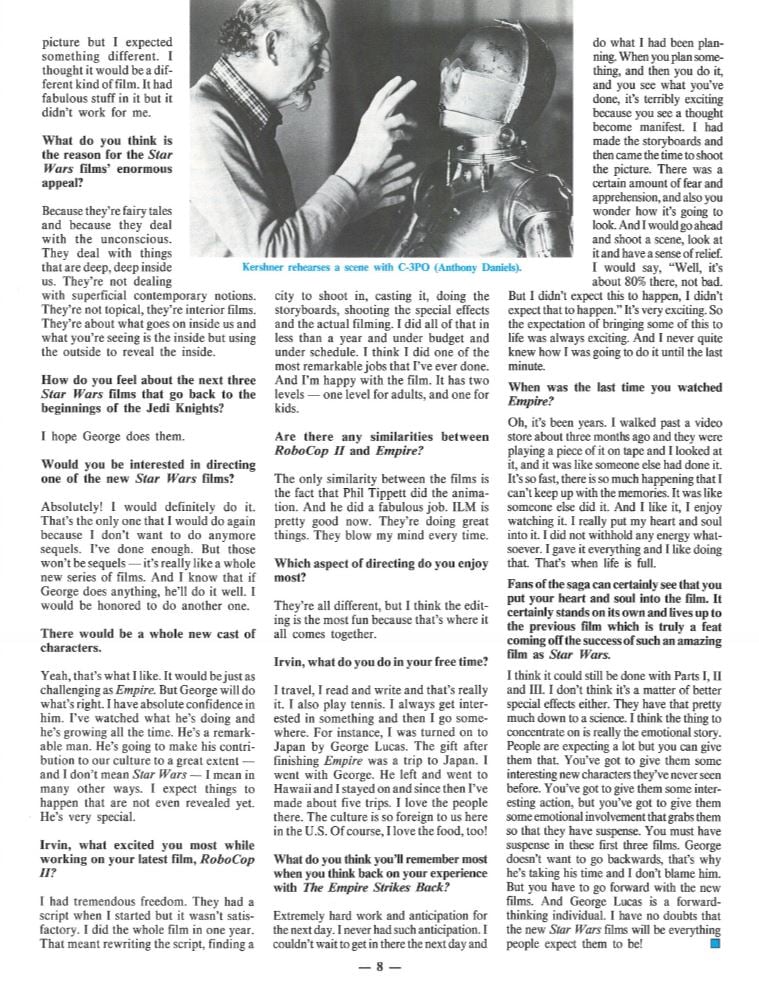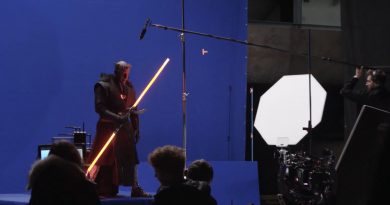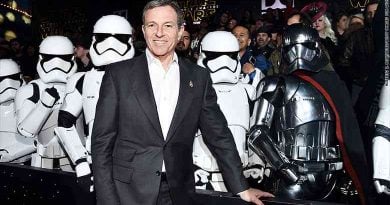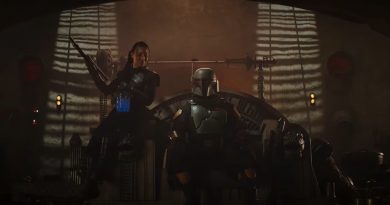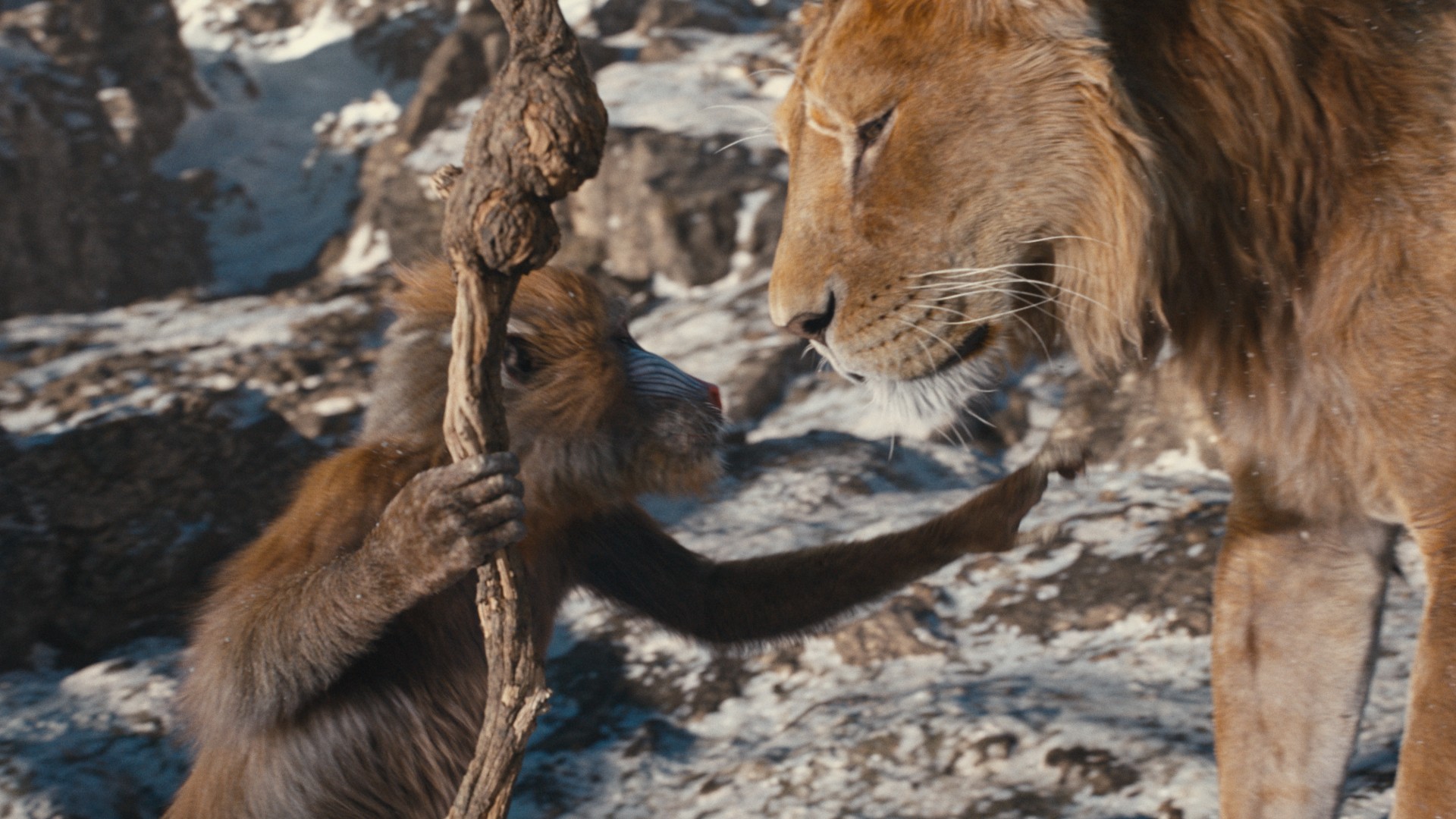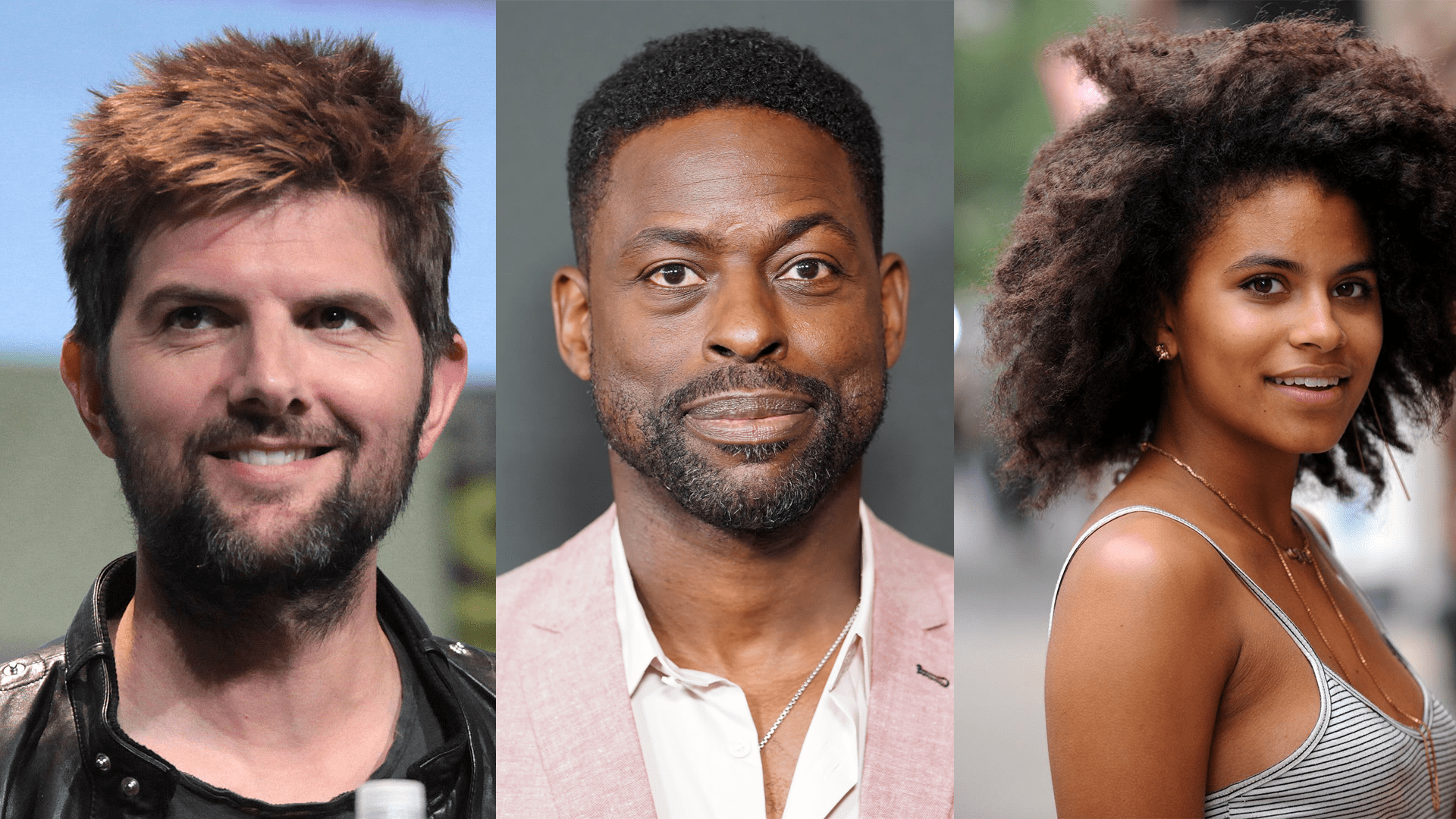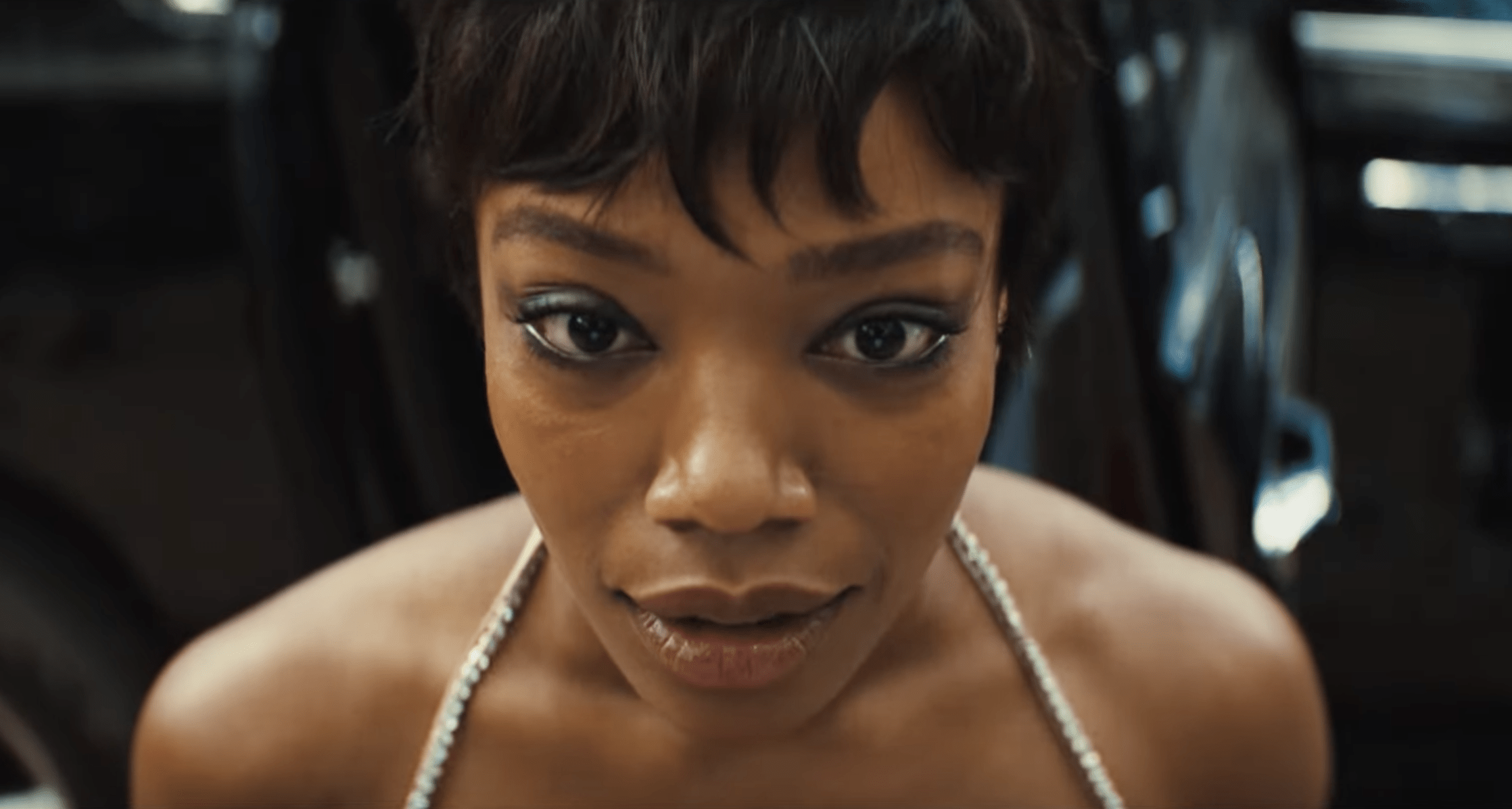“Irvin Kershner: Remembering The Empire Strikes Back” From the ‘Lucasfilm Fan Club’ #11 (1990)
I’m back reading through the back issues of the Lucasfilm Fan Club Magazine, and came across this peach of an interview with Irvin Kershner, the director of The Empire Strikes Back.
Irvin Kershner was a multi-talented individual who made significant contributions to the film and television industry. He was born in Philadelphia in 1923 and studied art at the Tyler School of Fine Arts at Temple University. After serving in World War II, he started his career in showbiz as a documentary filmmaker. He then transitioned to feature films, directing several movies across various genres.
Kershner died on November 27, 2010, at his home in Los Angeles, due to lung cancer.
The interview has some fantastic bits of information. This one in particular, I found rather hilarious after picturing it in my head:
The second day we were shooting, we had the Tauntaun’s out, which were frozen solid, and we couldn’t get the smoke to come out of the nostrils. So everybody had to smoke cigarettes and blow it into a bellows and it was pushed out.
Anyways, hope you find it as enjoyable and informative as I did.
Irvin Kershner: Remembering The Empire Strikes Back
A long time ago in a galaxy far, far away, director Irvin Kershner visited the mist-enshrouded swampy planet of Dagobah and the frozen, wind-whipped snowy world of Hoth. He guided Yoda in the ways of the Force, brought Luke, Han and Leia together on the planet Bespin, and arranged for Darth Vader and bounty hunter Boba Fett to carbon-freeze Han Solo for his trip back to Jabba the Hutt.
Greece and Turkey with the United States Information Service. When he returned to the states, although these events took place well over 10 years ago, Irvin Kershner recalls them as if they were yesterday. “The memory is a very vivid one,” he says, “because the people were so important to me and I like them all so much.” As director of the second chapter in the Star Wars saga, The Empire Strikes Back, Kershner worked closely with George Lucas to ensure that the continuity between the first film and the second remained intact while also adding his own special touch to the universe that Luke Skywalker lives in.
Affectionately known as “Kersh” by his admirers and friends, Irvin Kershner’s background is a mixture of music and art. The study of music — violin, viola and composition — was the most important activity of his early years. He attended the Temple University — Tyler School of Fine Arts in Philadelphia. Later, he went to New York and Provincetown to study with the famous painting teacher Hans Hofmann. He then moved to Los Angeles where he studied photography at the Art Center of Design. Kershner’s accomplishments as painter, photographer and musician are all evident in his work as a film director.
He began his film career at the USC School of Cinema teaching photography and taking cinema courses under Slavko Vorkapich, the great montage artist and then dean of the School of Cinema.
Kershner next accepted a job as still photographer on a State Department film project in Iran under the Four Point Program, which ultimately led to an assignment as a director and cinematographer of documentaries in Iran. He and the late Paul Coates developed Confidential File, a documentary television series. He later developed and directed the television series The Rebel, as well as the pilots for Peyton Place, Cain’s One Hundred, Philip Marlowe, etc.
He filmed Stakeout on Dope Street independently and when it was bought by Warner Bros., he was on his way. Some of his best known films are A Fine Madness with Sean Connery and Joanne Woodward, The Flim Flam Man starring George C. Scott, Up the Sandbox with Barbara Streisand, Return of a Man Called Horse starring Richard Harris, the critically acclaimed TV movie Raid on Entebbe, which was nominated for 9 Emmies, including Best Direction, The Eyes of Laura Mars starring Faye Dunaway and Tommy Lee Jones, Never Say Never Again, Sean Connery’s return to the role of James Bond, the HBO film Traveling Man starring John Lithgow, for which Kershner was nominated for an ACE Award, and his latest, RoboCop 2.
The Lucasfilm Fan Club recently met with Irvin Kershner to discuss his memories of working on The Empire Strikes Back.
Irvin, which directors, past or present, have influenced you?
I’m very much influenced by Akira Kurosawa and David Lean — I love every one of Lean’s films. I love the way he uses the environment and the way he tells a story.
What I love about Kurosawa is his imagery and his offbeat way of telling you a story without hitting you over the head. He’s a real storyteller. His film form is magnificent there’s not a wasted moment in a Kurosawa film. With all the great directors, you can see their humanity coming through in their films their concern for people and for the earth. But there are lots of other directors that I really love. The world is full of great film makers. But I tend to like the Europeans the most because of their humanistic approach to film.
Films in the United States are so expensive now that the film companies don’t seem to be able to take a chance with the films that won’t make 100 million dollars. So you see very few of them. Unfortunately, in Europe and in Asia, some of the best films are the small ones and in this country, the best films are the large ones — we’ve reversed the whole thing.
Do you recall how you were approached to direct The Empire Strikes Back?
I had a phone call from Gary Kurtz who asked me if I would be interested and I said I would think about it. I talked about it with my agent and I said, “Oh, what a hard act to follow! Star Wars! I don’t know.” I was kind of put off by the enormity of the job and having to not top it. I never believe in topping. I believe in just making something which stands on its own terms. I thought, “What a difficult job!” I met with George Lucas at Universal over lunch and he began talking about what he wanted to do and how important the second film was, because if the second one worked, then he could make more. If the second one didn’t work, then that would be the end of Star Wars So I thought about it and said, “Well, why do you want me? Of all the younger guys around, all the hot-shots, why me?” And I remember he said to me, “Well, because you know everything a Hollywood director is supposed to know but you’re not Hollywood.” I liked that. Of course, I’ve always liked George and respected him.
I loved his little films and his stuff at USC. I had some seminars with him when I was teaching and he was making some little films. I remember THX-1138 and, in fact, did my best to make Warner release it. They were reluctant to release it. So I finally decided, “Why not direct this Star Wars film.” How ever, I didn’t know it would take me almost three years.
So, I went up to see George and he took me to his office and showed me these drawings of what would later be Skywalker Ranch. He said, “This is what this film will pay for.” He showed me drawings of the buildings, etc. But he said, “This will only happen if Empire works.” And that was something else I had to carry on my shoulders. I thought, “Wow, what a dream! That’s incredible!”
You know, it’s not like saying, “Look, we’re going to make a lot of money!” It’s saving, “We’re going to build something.” And that was the difference for me. That’s what hooks me every time. You know, money itself means nothing. It’s what’s done with it that matters.
So, George convinced me. Actually, he didn’t have to try very hard. Once I got into it, I kept going up to San Francisco. Joe Johnston had drawn the first storyboards of the snow scene. Then we worked on the script for about three months. I had a penthouse apartment in Marin and George, myself and Larry Kasdan would meet and talk and Larry would go off and write. We would meet again a couple of days later and he would go off and write, etc. We totally rewrote the script.
I then went off to England and, for over a year, just worked on storyboards. There were no locations to look at except Norway and I made a few trips there. But the storyboards were going to be the film so I just worked on them. I filled up my walls with these pictures. Then I would bring in an artist who would make them pretty. We made a book and George had that back in California and I kept a copy. Everything was numbered and coded. The special effects and all the major sequences were indicated.
It’s a magnificent book. It shows every single important scene in the picture. After that, filming began. We started in a snow storm in which it was 26 degrees below zero. It was March in Norway. There was a windstorm blowing snow around. It was too cold to snow. It was supposed to be nice and calm then and it was so cold that I literally put the camera two feet outside the doorway of our hotel — that was all that existed where we were. I put the camera two feet outside and everybody stayed inside. And poor Mark Hamill had to go stumbling through the snow towards the camera. And shots like that we took the first day. It was so cold and snowy and windy we could hardly shoot.
After that, we had more luck with the weather. Then we went into the studio in England and stayed there — we never went outside.
We were supposed to have 8 stages for 64 sets. That was much bigger than Star Wars. Stanley Kubrick, in shooting his film, The Shining, burnt down one stage, which meant we were down to 7. Well, we were behind before we even started. To build these giant sets, shoot them, take them down and build another one and keep going was difficult. I think, at one point, there were up to 400 people working. They had every carpenter, every brick layer, etc. They had everyone who could lift up a hammer hammering and making plaster, etc. It was amazing. I would finish shooting, and the next day, the set would be rubble and by noon it would be swept clean and they would be laying out the next set. But, I’lI tell you, the organization of the Lucasfilm team is incredible! I would walk onto a set in the morning and the paint would be wet. I would have to walk around the edges to look at the set while it was drying. In an hour it would be dry and we would start shooting.
The Dagobah set where Yoda lived was unfinished when I started shooting on it. We had about 3½ to 4 feet of water on it. We had to put a 40-foot ship into that set. It had to go in head first and disappear under the water. The set was unfinished, though. So I had to start shooting many sequences from the last shot and work backwards because the set wasn’t completed where I had to start shooting. I would do the shot and everyone would stop building.
After the shot was completed, you would hear banging all around the place and see trees going up, etc. I had to shoot in the parts of the set that were completed. So it was a race. But I think every film is a race. It’s really a race against time, a race against disaster, a race against weather, etc. It’s always one step away. But I felt very relaxed on Empire.
You didn’t feel a little nervous about directing the follow-up to the most successful film of all time? The public had very high expectations for the film.
Well, you’re expressing that quality that makes for fear. But I put myself into a different frame of mind. My frame of mind was: I’m going to make a wonderful film that has nothing to do with Star Wars If people liked Star Wars, they will like this film. So I ignored the previous film. I did not compete with it at all.
I only looked at Star Wars once when I saw it at the Academy. I looked at it once more on the Kemp and I never looked at it again. I wanted to get my own style. I wanted to move the camera more, when possible. I wanted to use the camera in an exciting way. Most of the time that’s not possible because of the special effects. It was a matter of rhythm. So I kept in mind the Empire set in London, rhythm of the piece I didn’t want to make it too fast, I didn’t want to make it too slow. I felt it would be a slower film than Star Wars because it was the second act.
What was your impression of the Star Wars cast?
I loved the actors. I thought that they were very creative people. I thought that Carrie was going to have a terrific career. Harrison I adored because he was so creative and so much fun. We really had fun making the picture. We would try things. I would have an idea at the last minute and would go running up to Harrison and say, “Harrison, listen to this: instead of running down the steps, you just stand there and let them come at you. And then you’ll jump!” And he would say, “Yeah, yeah, let’s try it!”
I’ll tell you, Peter Mayhew, who played Chewbacca, worked so hard. He kept fainting from the heat in his costume. But the whole cast and crew were just good people.
And they cared. We worked hard – we shot for 6 months and people just kept getting sick and, at times, it really dragged. But, you know what? I couldn’t wait to come in every day. I got caught up in the film and I began to believe this world. I began to feel the real world was kind of boring. When I would walk onto one of these giant sets with these hangar doors opening and all these spaceships and such, I felt, “Boy, this is a much more interesting world than the real world.” I would have loved to have entered that world. It was exciting — things were happening. I think that the director has to believe in the world that’s being created. I don’t care if it’s a comedy, a drama, or about killers or whatever. you have to feel the same anxieties, the same passions that are being felt in that phony world you’re creating.
A good example of trying to believe in this world, for me, was Yoda. Yoda was the most difficult thing to shoot. It was like pulling teeth but it was exciting! When you saw the rushes, you saw something come alive that had never been done on film – a piece of rubber and plastic, not acting as a puppet, but acting as a living thing. It was a character that would swallow and breathe and blink. He was incredible! Frank Oz did a great job with his team.
You know, when we were shooting on the Dagobah set, I had to wear a gas mask for a lot of the time. I had a mike built into my mask and earphones put on so I could hear Frank below the stage because you couldn’t hear anything above the stage.
Mark Hamill had to remember the lines that were being said to him because he was playing to a mute. I could hear both, though. But I couldn’t stand the smoke after a while. There was so much smoke on Dagobah! I began to get very sick so I wore a gas mask — an old World War II gas mask with a mike built in so they could hear me.
How were you first introduced to the character of Yoda?
When we came over to England, we knew there was going to be a Yoda but we didn’t know what he would look like. We talked about using monkeys, then a chimpanzee, then we thought maybe we would use a little kid, then we thought maybe he would be 8ft tall — huge with a big white beard like Moses. It kept going all over the place. Finally, the engineer/make-up man, a wonderful guy in England, who worked with the Frank Oz team, designed this head and brought it in one day. That was one of the few times George Lucas flew over. He was only there about three times for a day or two. He stayed in California because he had his hands full. He would get the rushes, which would be very bad. We would photograph the image on a Moviola and send it to him. We kept everything because I was cutting we went.
But George only showed up on the set about three times. George was wonderful. He left me alone. If I had any doubts about a scene or if I wanted to cut a scene out or cut it down, or make a big change, I would call him on the phone and we would discuss it. And we would always come to an agreement very quickly. If it was small changes, I would just make them. But I would never deviate from the storyboards that I had made. If I deviated, I would always call him because he was in the special effects unit. I would say, “The ship is not going to come in from the right but from the left. Therefore, reorient that whole scene.” I would let him know ahead of time so that they wouldn’t build stuff they didn’t need. We were in touch that way but I didn’t call him that many times.
I was shocked one day: I’m shooting, and I look over and way in the back of about 50 people is George standing there. And I said, “George, come over here!” He was sort of embarrassed, he’s so shy! So he came over and watched the shooting. That was the morning that we shot a scene that ended up about 6 seconds on film and it took us 10 hours to shoot! Everything kept breaking! Nothing worked! (Laughter) And George just stood there and never said a word. George is just about the best producer I’ve ever worked with. He made sure that everything was there.
Back to Yoda for a minute. Wasn’t there more than one of the puppets made?
Yes, we made three Yodas. The eyes were supposed to blink and they were supposed to focus when he looked at something close and move apart when they focused on something far. Well, they didn’t quite work. You know, in the whole film, I saw only one as blink on film because they couldn’t make it. And I wanted him to blink because that gives you a reality. Well, I saw only one blink but the moves were great and only one of the Yodas was working.
I remember once we had agreed on the look of Yoda, I couldn’t find anything to dress him with. I looked around and they brought me different cloths and finally I found the texture that I thought would work. It was thick, raw silk from a piece of Indian cloth. And they actually sent to India and got the cloth. It looked handmade, like Yoda had made it himself. But it was heavy, heavy raw silk — I’m sure a bullet wouldn’t have gone through it! It was rough-textured with a wonderful natural color and that’s what he wore. And we found it at the last minute.
What do you recall most about working on the film?
There were so many things that were happening every day. It was incredible. But, you see, I wasn’t trying to beat Star Wars. I was just trying to make a film and get the characters to come alive. I wanted to keep the rhythm going and watch the story — I was interested in telling the story and as economically as possible. And, of course, the one thing I looked for every day was humor.
How can I get people to laugh? But not laughing at them, but laughing with them. That was important because you’re always skating on thin ice due to the fact that everything is so unbelievable. So you have to make some humor.
Also, a lot of things don’t work when you build them. Some of the best stuff was simply grabbing a hand-held camera and shouting, “Left, right” and the actors throw themselves to the left and throw themselves to the right and the camera moves in the opposite direction. That’s what we did in the scene where the Millennium Falcon is in the bowels of the giant worm. That was just a hand camera and me shouting, “Right … left… right.” And when we looked at it, it was perfect. You can’t move the ship set, which was 30 tons, so we found another way to make the scene look believable.
We did a lot of hand-held stuff. For instance, I needed the rocks to rise when Luke gets the power on Dagobah. Well, we didn’t have any rocks. It wasn’t prepared, so the art director on the set said “I can make them really fast.” He ran off and he made paper mache rocks with little wires on them and brought them back. It took about two hours, and we shot them. But this is how you make a film like that. You have to stay on top of it and you have to think constantly. You have to improvise every day but you tell your story. You can do all the playing around you want as long as you tell your story and you let the characters define themselves. You don’t depend on the action; you depend on the characters doing the action.
The Star Wars films have been described as using elements of myth and legend. In what ways do the films display these mythic qualities?
Well, when I took the job, I had never been a reader of science fiction. I read Asimov and Bradbury but I never really read all the other great stuff. So I decided that, instead of suddenly trying to make myself an expert on science fiction, I would do what I believed Star Wars was really all about — they’re fairy tales. They’re not science fiction, they’re fairy tales. So l got a hold of some books — a Freudian interpretation of fairy tales, a Jungian interpretation of fairy tales. I read foreign fairy tales, etc. The reason fairy tales are so effective for children is because they deal with the anxieties that children feel as they grow up: the anxiety of wondering whether their parents are really their parents, are their parents going to abandon them? They’re afraid of being lost, etc. All these fears are manifest with children. That’s what their nightmares are all about. And fairy tales are a sort of waking nightmare. So I studied fairy tales and that’s why, when I got into the part that Luke Skywalker discovers he’s Darth Vader’s son, I found elements of that theme in fairy tales.
But that story point was kept a secret. We didn’t even have that in the script. Nobody knew that, not even the actors. I had a page that I took when I was in California that was a substitute page for the scene when Luke is screaming at Vader and hanging on to that pole. Those words were put away in my book and when it came time to shoot, I explained it to Mark. But when he was saying, “No, no, I don’t believe it!” Darth Vader was saying totally different things than what you hear in the film. He wasn’t saying, “I am your father! We’ll rule the galaxy together!”
He was saying, “You’re going to do what I say!” (Laughter) So he had totally different lines. Then, when we went to put it together, we put the real words in. But Mark knew because I told him ahead of time. I told him he was Vader’s son and he thought it was great. And he acted it magnificently! He was hanging there by a nylon cord over 40 feet of nothing with wind blowing at him. I had fans and smoke aimed right at him. It was really quite dangerous — I worried about it. And I think he was worried about it, too, and that’s what made it so effective.
When I went to the Command Performance in England of The Empire Strikes Back, in back of me was sitting David Prowse who was the body of Darth Vader.
When the scene came on where Vader says, “I am your father,” David hit me on the head! (Laughter) He leaned over and said, “Why didn’t you tell me! I would’ve acted it differently!” (Laughter) David wasn’t the voice of Darth Vader but he sure walked right! I tell you: body language is so important. Peter Mayhew was not an actor but he did so well as Chewbacca. He’s a sweet, sweet man! Peter got sick, he passed out from heat prostration because of the wool suit. He just passed out one day. We took him away and gave him a few days off. So I brought in somebody who was just as big and put on the costume. I had him do just a few little things like turning and raising his arm or walking away, etc. And I had to throw all of that footage out! He didn’t look like Peter. Peter had a certain walk, a certain way of holding his head and it was right. So I couldn’t use a double for him, the same way you can’t use a double for Darth Vader. David had a way of strutting which was unique.
Which sets from Empire impressed you most?
Oh, the sets were gorgeous! There were three that impressed me the most. One set was Dagobah. I didn’t know how we were going to shoot it. There were trees, and hills, and bushes, and 4 feet of water and it was slippery and pretty dangerous. That set was pretty impressive, though. When you smoked it up and you had clouds hanging in the air, it was magnificent! We closed all the doors and stopped all the air movement and then they sprayed this vegetable stuff and you actually had the mist hanging in layers. We all had to stand still quietly until the air settled and then blow the stuff in. We would shoot the scene and then the mist would all go to hell as soon as we started moving. But that scene was impressive.
The next impressive set was the large hangar with the big spaceship. That was impressive and, in fact, I didn’t know how we were going to shoot that one either! It really baffled me! It was so big and there was so much going on. We also had a lot of special effects to do there. When Harrison Ford runs in on the Tauntaun, that was one of the trickiest shots in the whole film. People had to get out of the way because we couldn’t have overlays.
The other set that I was impressed with was the “black” set where Han Solo goes to be frozen. That was 30 feet up in the air and it was a black set. There were no guardrails and it was a round set with about 50 tons of junk hanging overhead, which we got from junkyards. It was just junk but it was so impressive looking! You walk up those steps and it just looked great! But it was difficult.
First of all, have you ever shot on a round set?! It’s almost impossible. So I did the whole thing from one side making it the reverse also so that you felt whatever you saw here was on the other side as well. We wouldn’t have to relight the set that way. The only problem was that all the little people were standing around with their faces 3 feet off the ground and steam was shooting up through the holes at them. They were fainting all the time. So we had to correct that but that set was difficult to shoot on.
Speaking of problems, was it difficult shooting the snow scenes in Norway keeping in mind all the time that the Imperial walkers would have to be placed in the scene at a later date?
Well, we had storyboards. On previous trips up to Norway, I laid out where the trenches would be and that was laid out according to the space we had for the Walkers in the background. But it wasn’t difficult to do. You just had to assume that the Walkers were right there wherever the shot was. We had some good motion control shots during the Walker sequences as well.
It was very cold in Norway. You know what the biggest problem was in working there? Going to the bathroom! We had on seven layers of clothes. We were up on a glacier and nobody could go to the bathroom! We were dying! It was one of the most difficult things!
(Laughter) We always ran into the sauna in the hotel afterwards and then ran out into the snow. We would go from the sauna into the snow. I learned to do it; it was great!
The second day we were shooting, we had the Tauntaun’s out, which were frozen solid, and we couldn’t get the smoke to come out of the nostrils. So everybody had to smoke cigarettes and blow it into a bellows and it was pushed out. But we were trying to keep the Tauntauns secret. They were all wrapped and in boxes and suddenly we had them out in the snow for the first time and Mark had to jump up on one.
Suddenly, a helicopter came overhead. The Norwegian Airforce were doing manoeuvres. It started circling around and we saw a guy leaning out with a long camera lense — a civilian. He started snapping pictures of the guys on the Tauntauns. So we called the base and they found one of the pilots had been bribed by one of the newspapers in England. They got a scoop — they actually had a picture in the paper of us working. I think the RAF really came down on the pilot for doing that.
Many fans thought that the Emperor in Empire looked a lot like Obi-Wan Kenobi. Was that intentionally done?
Absolutely not. There was no attempt to do that. I can see the similarity but that was a made-up face. Totally manufactured.
What is your favourite sequence in the film?
I couldn’t really tell you because there are so many sequences I like in the film. I do love the scene where Mark lands on Dagobah and meets Yoda. I never thought that would work. That was the scariest sequence to shoot but I loved it when it was finished.
From the time Luke lands in the water to the time he meets up with Yoda was my favorite piece in the film and that’s because it was the most difficult to shoot. I was so relieved that it worked and it turned out to be my favorite sequence.
I also loved the scene where Harrison goes to be frozen. That’s a very, very complex scene. That is as complex a scene as anything on the whole film. It may be the most complex. It was a round set and I had all those stairs plus I had every character in there!
Everybody was in there and interacting. It was a killer! It was a technical triumph to just get it working, let alone working well. I think I feel proudest of that sequence. It also has a lot of emotional color.
Would you say that Empire is the most difficult film you’ve directed yet?
Oh, yeah! RoboCop 2 was pretty difficult but nothing like Empire. It was just full of challenges every day. It was very rough.
10 years later, would you do anything differently?
I would reshoot the whole film. I would do it a whole new way because I’ve learned a lot about myself. My attitude towards the story has changed somewhat.
Empire was certainly a darker story than Star Wars.
The middle story is the most difficult because it doesn’t have a grand climax.
It had no climax. I had to make an emotional climax. That’s why I put in specifically the feeling in Luke’s hand where he feels a little pinprick. I wanted that just because I felt that in the third film, it would attempt to be a love story, and to feel that he’s got a rubber hand there, touching a woman, would have been horrible. So I gave him feeling.
Were you pleased with the next film, Return of the Jedi?
It didn’t quite work for me. It was a nice picture but I expected something different. I thought it would be a different kind of film. It had fabulous stuff in it but it didn’t work for me.
What do you think is the reason for the Star Wars films’ enormous appeal?
Because they’re fairy tales and because they deal with the unconscious. They deal with things that are deep, deep inside us. They’re not dealing with superficial contemporary notions. They’re not topical, they’re interior films. They’re about what goes on inside us and what you’re seeing is the inside but using the outside to reveal the inside.
How do you feel about the next three Star Wars films that go back to the beginnings of the Jedi Knights?
I hope George does them.
Would you be interested in directing one of the new Star Wars films?
Absolutely! I would definitely do it. That’s the only one that I would do again because I don’t want to do anymore sequels. I’ve done enough. But those won’t be sequels — it’s really like a whole new series of films. And I know that if George does anything, he’ll do it well. I would be honored to do another one.
There would be a whole new cast of characters.
Yeah, that’s what I like. It would be just as challenging as Empire. But George will do what’s right. I have absolute confidence in him. I’ve watched what he’s doing and he’s growing all the time. He’s a remarkable man. He’s going to make his contribution to our culture to a great extent and I don’t mean Star Wars — I mean in many other ways. I expect things to happen that are not even revealed yet.
He’s very special.
Irvin, what excited you most while working on your latest film, RoboCop 2?
I had tremendous freedom. They had a script when I started but it wasn’t satisfactory. I did the whole film in one year. That meant rewriting the script, finding a city to shoot in, casting it, doing the storyboards, shooting the special effects and the actual filming. I did all of that in less than a year and under budget and under schedule. I think I did one of the most remarkable jobs that I’ve ever done.
And I’m happy with the film. It has two Levels — one level for adults, and one for kids.
Are there any similarities between RoboCop 2 and Empire?
The only similarity between the films is the fact that Phil Tippett did the animation. And he did a fabulous job. ILM is pretty good now. They’re doing great things. They blow my mind every time.
Which aspect of directing do you enjoy most?
They’re all different, but I think the editing is the most fun because that’s where it all comes together.
Irvin, what do you do in your free time?
I travel, I read and write and that’s really it. I also play tennis. I always get interested in something and then I go somewhere. For instance, I was turned on to Japan by George Lucas. The gift after finishing Empire was a trip to Japan. I went with George. He left and went to Hawaii and I stayed on and since then I’ve made about five trips. I love the people there. The culture is so foreign to us here in the U.S. Of course, I love the food, too!
What do you think you’ll remember most when you think back on your experience with The Empire Strikes Back?
Extremely hard work and anticipation for the next day. I never had such anticipation. I couldn’t wait to get in there the next day and do what I had been planning.
When you plan something, and then you do it, and you see what you’ve done, it’s terribly exciting because you see a thought become manifest. I had made the storyboards and then came the time to shoot the picture. There was a certain amount of fear and apprehension, and also you wonder how it’s going to look. And I would go ahead and shoot a scene, look at it and have a sense of relief.
I would say, “Well, it’s about 80% there, not bad. But I didn’t expect this to happen, I didn’t expect that to happen.” It’s very exciting. So the expectation of bringing some of this to life was always exciting. And I never quite knew how I was going to do it until the last minute.
When was the last time you watched Empire?
Oh, it’s been years. I walked past a video store about three months ago and they were playing a piece of it on tape and I looked at it, and it was like someone else had done it.
It’s so fast, there is so much happening that I can’t keep up with the memories. It was like someone else did it. And I like it, I enjoy watching it. I really put my heart and soul into it. I did not withhold any energy whatsoever. I gave it everything and I like doing that. That’s when life is full.
Fans of the saga can certainly see that you put your heart and soul into the film. It certainly stands on its own and lives up to the previous film, which is truly a feat coming off the success of such an amazing film as Star Wars.
I think it could still be done with Parts I, II and III. I don’t think it’s a matter of better special effects either. They have that pretty much down to a science. I think the thing to concentrate on is really the emotional story.
People are expecting a lot but you can give them that. You’ve got to give them some interesting new characters they’ve never seen before. You’ve got to give them some interesting action, but you’ve got to give them some emotional involvement that grabs them so that they have suspense. You must have suspense in these first three films. George doesn’t want to go backwards, that’s why he’s taking his time and I don’t blame him.
But you have to go forward with the new films. And George Lucas is a forward thinking individual. I have no doubts that the new Star Wars films will be everything people expect them to be!
Alexander has been a lifelong Star Wars fan having started watching with his elder brother in the early 80's through to watching The Phantom Menace with same brother in cinema as a 21 year old with beer.
His love for the franchise has never waned.
A published comic book writer and letterer but when not watching or reading Star Wars is usually hacking computers for work.
Follow on twitter @Muldwych

